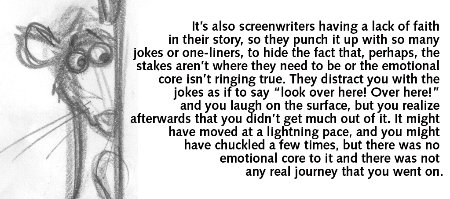Rhett Wickham: Every Little Thing That Goes Into the Soup
Page 2 of 4

Click here for a much larger version of this picture
RW
It’s akin to Chris Sanders’ designs for Nani in Lilo and Stitch.
MW
Oh!!! Absolutely! I love that stuff. It’s attractive and it’s different.
RW
These characters have such a strong graphic appeal to them, unique to being invented. Their anatomically impossible shapes and forms, for one thing, are a large part of what makes you want to watch them. They are more fluid, more interesting than anything you could capture in live action. It’s the same problem motion capture has, and will always have, in that no matter how hard you try or what level of acrobatic skill the “captured�? actor has, it still looks like a guy in a gorilla suit, because they’re bound by the very real physical limitations of life, not art. This is a story that has every reason to be animated.
MW
I’m glad to hear you say that. You know years later they made The Jungle Book into a live action feature, and 101 Dalmatians as well. They’re both from books, so they’re free game. But I guess that in the year 2060 if they wanted to make a live-action Ratatouille, I suppose they could. But the stuff that we look at is caricature. Motion capture certainly has its place, but we don’t use it – and people ask us all the time why we don’t use motion capture, especially for humans – the thing for us, and it’s the same as it always had been for Walt and Milt (Kahl) and all the greats, is that it’s caricature. If someone is painting a bowl of fruit, their particular take on a bowl of fruit is much more interesting than a bowl of fruit, at least to us.
What you’ll see in Ratatouille is that the movement in it is pushed, stuff that you just could not do in motion capture or live action. It would be so dumbed down. Yet, they’re believable as human beings – they’re not made out of Jell-O or anything like that; they move as if they have weight and they’re believable.
Brad Bird is very big on making things move believably and have weight, so that you believe that if someone gets hurt that there’s real stakes. You can do things with Bugs Bunny in a short, or Daffy Duck where he gets hit on the head with a shovel and then gets back up again, But it’s harder to tell a story where you want the audience to be worried about the main characters - “What happens if this happens?!�? or “What about that�? - if they think that they’ll just bounce back then there’s no tension, and there’s nothing to worry about.
RW
No. And if the stakes aren’t real then you can’t raise them, which you have to do in film. We don’t go to the theatre to see the ordinary, we go to see the extraordinary. Peril has to be more than ordinary, it has to be extraordinary peril.
MW
Absolutely. If you reach the climax of the film and suddenly the villain has a gun pointed to your hero, and you spent the whole rest of the movie with your hero falling out of ten story buildings and bouncing up again, then you think ‘Well, so what? Shoot him. He’ll just bounce back again. You’ll see in Ratatouille we spent time on weight, so that later on in the film things are believable.
RW
It’s certainly important to set up Remy as being that vulnerable, because otherwise we don’t share in the feeling of being at risk, so small and fragile in this kitchen of knives and flames and boiling pots. It’s also nice that it lets him share something with Linguini, who is enormously emotionally vulnerable, and together they make a whole that lets us care for them both – particularly when they reach a crisis between them. The schism feels greater because we feel as if a “whole�? has been separated, wrongly.
MW
And you buy their friendship, because you believe they’re both getting something out of it. It creates a dynamic in their relationship where Linguini is getting something out of Remy, but it becomes untenable for Remy because he’s not getting any credit and feels like he’s not getting any respect, and this guy wouldn’t have anything without him. It’s hard that he’s not accepted in the kitchen, he’s not accepted by his family, he’s not really accepted anywhere. That’s the kind of stuff as an animator, you know, as an actor, that’s the really interesting thing to get your hands on.

Click here for a much larger version of this picture
